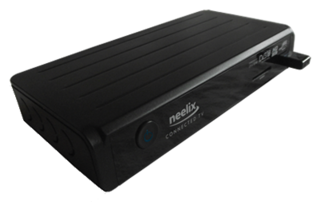
A set-top box (STB) or set-top unit (STU) is an information appliance device that generally contains a TV-tuner input and displays output to a television set and an external source of signal, turning the source signal into content in a form that can then be displayed on the television screen or other display device. They are used in cable television, satellite television, and over-the-air television systems, as well as other uses.

Video on-demand (VOD) is a form of video media distribution that allows users to consume TV and movie content whenever they choose, instead of having to watch shows at a scheduled broadcast time. During the 20th century, the major form of media distribution was broadcast in the form of over-the-air programming. The development of the Internet and IPTV technology in the late 20th century resulted in a significant switch in content consumption habits with VOD coming to televisions and personal computers. Unlike broadcast TV, video on demand previously required each user to have an internet connection with considerable bandwidth to access the content effectively. However since the Digital Cinema Initiative was launched in 2002 by Disney, Paramount, Sony Pictures Entertainment, Universal and Warner Bros. Studios, the JPEG2000 codec was developed alongside the Fraunhofer Institute for the distribution of movies via Digital Cinema Packages. Subsequently, this technology has filtered down from feature film production into broadcast television which has necessitated substantially less bandwidth for VOD applications.
Ericsson Television, formerly Tandberg Television, is a company providing MPEG-4 AVC, MPEG-2 and HEVC encoding decoding and control solutions, plus stream processing, packaging, network adaption and related products, for Contribution & Distribution (C+D), IPTV, Cable, DTT, Satellite DTH and OTT.

Interactive television is a form of media convergence, adding data services to traditional television technology. Throughout its history, these have included on-demand delivery of content, as well as new uses such as online shopping, banking, and so forth. Interactive TV is a concrete example of how new information technology can be integrated vertically rather than laterally.
The Grand Alliance (GA) was a consortium created in 1993 at the behest of the Federal Communications Commission (FCC) to develop the American digital television and HDTV specification, with the aim of pooling the best work from different companies. It consisted of AT&T Corporation, General Instrument Corporation, Massachusetts Institute of Technology, Philips Consumer Electronics, David Sarnoff Research Center, Thomson Consumer Electronics, and Zenith Electronics Corporation. The Grand Alliance DTV system is the basis for the ATSC standard.

Moxi was a line of high definition digital video recorders produced by Moxi Digital, Digeo, and then Arris Group. Moxi was originally released only to cable operators, but in December 2008 was released as a retail product, and removed from the market November 2011. The former retail product, the Moxi HD DVR, provides a high definition user interface with support for either two or three CableCARD TV tuners. Arris also offered a companion appliance, the Moxi Mate, which can stream live or recorded TV from a Moxi HD DVR.
A Technology and Engineering Emmy Award is given by the National Academy of Television Arts and Sciences (NATAS) for outstanding achievement in technical or engineering development. An award can be presented to an individual, a company, or to a scientific or technical organization for developments and/or standardization involved in engineering technologies which either represent so extensive an improvement on existing methods or are so innovative in nature that they materially have affected the transmission, recording, or reception of television. The award is determined by a special panel composed of highly qualified, experienced engineers in the television industry.

Showtime Networks Inc. (SNI) is an American entertainment company that oversees the company's premium cable television channels, including its flagship service Showtime. It is a subsidiary of media conglomerate CBS Corporation.PYAE showtime network.

Mobile television is television watched on a small handheld or mobile device. It includes pay TV service delivered via mobile phone networks or received free-to-air via terrestrial television stations. Regular broadcast standards or special mobile TV transmission formats can be used. Additional features include downloading TV programs and podcasts from the Internet and storing programming for later viewing.

A digital television adapter (DTA), commonly known as a converter box, is a television tuner that receives a digital television (DTV) transmission, and converts the digital signal into an analog signal that can be received and displayed on an analog television set. The input digital signal may be over-the-air terrestrial television signals received by a television antenna, or signals from a digital cable system. It normally does not refer to satellite TV, which has always required a set-top box either to operate the big satellite dish, or to be the integrated receiver/decoder (IRD) in the case of direct-broadcast satellites (DBS).
The 57th Technology & Engineering Emmy Awards was held on 29 September 2005. The National Television Academy announced the winners at Bristol-Myers Squibb in Princeton, New Jersey.
Valups Corporation is a company based in Seoul, Korea which makes products for watching mobile television.
The 58th Technology & Engineering Emmy Awards was held on January 8, 2007. The National Television Academy announced the winners at The Venetian Hotel in Las Vegas. DIRECTV's Eddy Hartenstein received the Lifetime Achievement Award for his role in the company's becoming a global provider of digital television.
ATSC 3.0 is a major version of the ATSC standards for television broadcasting created by the Advanced Television Systems Committee (ATSC). ATSC 3.0 comprises around 20 standards covering different aspects of the system and in total will have over 1,000 pages of documentation.
Dwight Marcus was the Chief Technology Officer and one of the co-founders of NPOWR Digital Media. He attended Worcester Polytechnic Institute, where he was a Henry J. Fuller Scholar. Marcus is also the inventor of the stimTV Network, which in 2007 won the Technology and Engineering Emmy Award from the National Academy of Television Arts and Sciences.
Richard (Dick) Green is Director of Liberty Global Corporation, Shaw Communications Inc., and currently serves as chairman of the Space Sciences Institute and the University of Colorado Boulder's ATLAS Institute in Boulder, Colorado. He previously served as President and CEO of not-for-profit research and development consortium CableLabs.
The 60th Technology & Engineering Emmy Awards was held on January 8, 2009 at the 2009 International Consumer Electronics Show in Las Vegas. CEO of Verizon Communications, Ivan Seidenberg received the Lifetime Achievement Award
Woo Paik or Paik Woo-hyun is a Korean engineer and inventor. Paik’s contributions to digital television have been recognized through numerous awards and honors, and for this reason, he is sometimes referred to as the "Father of HDTV." He is the author of numerous technical papers and co-inventor of more than 25 inventions earning U.S. Patents in the area of digital video compression, digital transmission, and digital signal processing.
SeaChange International is a multinational supplier of Video Delivery Software Solutions that power cloud and on-premise video delivery platforms worldwide. They provide content and service providers with a complete software delivery platform for linear, VOD and TSTV over managed and unmanaged networks. The SeaChange Framework solution includes video back-office, media asset management, targeted advertising management, analytics and the client interface for STBs, Smart-TVs and mobile devices.
A Primetime Emmy Engineering Award is an award given most years by the Television Academy, also known as the Academy of Television Arts & Sciences (ATAS). It is a Primetime Emmy Award given specifically for Outstanding Achievement in Engineering Development. According to the Television Academy, the Primetime Emmy Engineering Award is presented to an individual, company or organization for engineering developments so significant an improvement on existing methods or so innovative in nature that they materially affect the transmission, recording or reception of television. The award, which is Television's highest engineering honor, is determined by a jury of highly qualified, experienced engineers in the Television industry.










